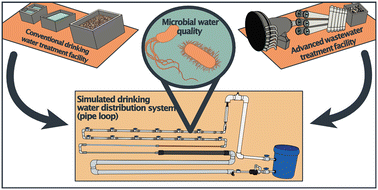Stay in the loop: lessons learned about the microbial water quality in pipe loops transitioned from conventional to direct potable reuse water†
Abstract
Direct potable reuse offers water-scarce regions a local and reliable source of drinking water, but few studies have investigated the effect of introducing advanced-treated wastewater to drinking water distribution systems on microbial water quality. We aimed to characterize the impact on microbial water quality of transitioning a drinking water distribution system fed with conventionally-treated surface water to a blend with advanced-treated wastewater. Three pipe loops were fed with the same source water (conventional water alone or blended with advanced-treated wastewater) for 21 weeks, and two pipe loops transitioned from conventional water to advanced-treated wastewater (i.e., conditioned reverse osmosis permeate) after the first 10 weeks. Microbial water quality was evaluated via flow cytometry-based cell counts, adenosine triphosphate concentrations, quantitative PCR, and 16S rRNA gene amplicon sequencing. Handling (i.e., conveyance, transportation, and storage) of reverse osmosis permeate introduced bioavailable carbon, which resulted in high microbial abundance in the advanced-treated wastewater that was fed to the pipe loops. In the pipe loops, the microbial community profile in the bulk water and biofilm reflected that of the primary feedwater (i.e., conventionally-treated surface water or advanced-treated wastewater). The antibiotic resistance gene sul1 was detected in all samples, increased in absolute abundance in the RO permeate after handling, and increased in relative and absolute abundance in the bulk water and biofilm of pipe loops after the transition. In addition, 21 amplicon sequence variants (ASVs) were significantly enriched or depleted in the bulk water and biofilm of pipe loops after the transition Of these ASVs, one Pseudomonas-classified ASV was present in the RO permeate, increased in estimated absolute abundance during RO handling, and remained at high estimated absolute abundance in pipe loops fed with primarily advanced-treated wastewater. Thus, advanced-treated wastewater has potential to be a source of antibiotic resistance and opportunistic pathogens in drinking water distribution systems. Though these contaminants will likely be low in abundance following treatment, nutrients introduced during storage or conveyance of advanced-treated wastewater could increase the abundance of antibiotic resistance genes and opportunistic pathogens. To ensure that risks are not elevated compared to conventional source waters, enhanced monitoring is recommended, that begins two years before the transition to direct potable reuse, continues for two years after, and includes absolute microbial abundance as well as screening for opportunistic pathogens and antibiotic resistance genes.

- This article is part of the themed collection: Recent Open Access Articles


 Please wait while we load your content...
Please wait while we load your content...